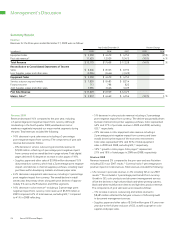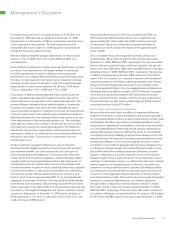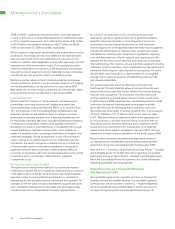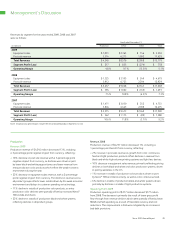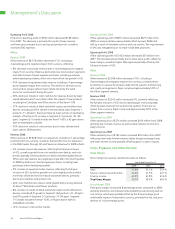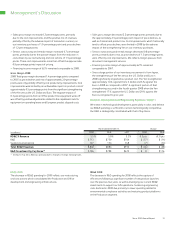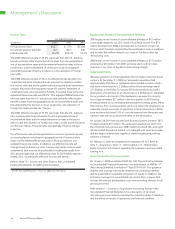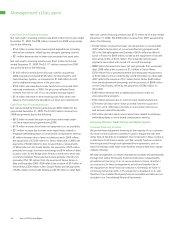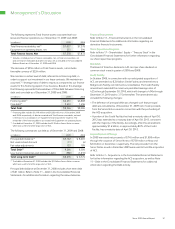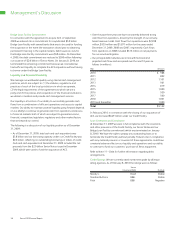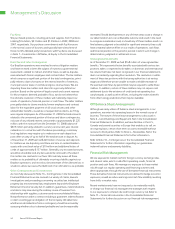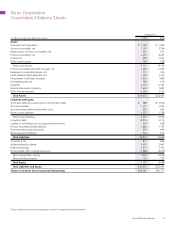Xerox 2009 Annual Report Download - page 35
Download and view the complete annual report
Please find page 35 of the 2009 Xerox annual report below. You can navigate through the pages in the report by either clicking on the pages listed below, or by using the keyword search tool below to find specific information within the annual report.
33Xerox 2009 Annual Report
Management’s Discussion
Currencylosses,net:Currency losses primarily result from the
re-measurement of foreign currency-denominated assets and liabilities,
the cost of hedging foreign currency-denominated assets and liabilities,
the mark-to-market of foreign exchange contracts utilized to hedge
those foreign currency-denominated assets and liabilities and the
mark-to-market impact of hedges of anticipated transactions, primarily
future inventory purchases, for those that we do not apply cash flow
hedge accounting treatment.
The 2009 currency losses were primarily due to the significant
movement in exchange rates among the U.S. Dollar, Euro and Yen
in the first quarter of 2009, as well as the increased cost of hedging,
particularly in developing markets.
The 2008 currency losses were primarily due to net re-measurement
losses associated with our Yen-denominated payables, foreign currency-
denominated assets and liabilities in our developing markets and the
cost of hedging. The currency losses on Yen-denominated payables were
largely limited to the first quarter 2008 as a result of the significant and
rapid weakening of the U.S. Dollar and Euro versus the Yen.
Amortizationofintangibleassets: The increase in 2009 and 2008
amortization as compared to prior years primarily reflects the full-year
amortization of the assets acquired as part of our recent acquisitions.
Litigationmatters: In 2008 legal matters consisted of the following:
•$721 million reflecting provisions for the $670 million court approved
settlement of Carlson v. Xerox Corporation (“Carlson”) and other
pending securities-related cases, net of expected insurance recoveries.
On January 14, 2009, the United States Court for the District of
Connecticut entered a Final Order and Judgment approving the
settlement of the Carlson litigation.
•$36 million for probable losses on Brazilian labor-related contin-
gencies. Following an assessment of the most recent trend in the
outcomes of these matters, we reassessed the probable estimated
loss and, as a result, recorded an additional reserve of $36 million in
the fourth quarter of 2008.
•$24 million associated with probable losses from various other legal
matters.
Refer to Note 16 – Contingencies in the Consolidated Financial
Statements for additional information regarding litigation against
the Company.
Allotherexpenses,net: All Other expenses in 2009 were $19 million
higher than the prior year, primarily due to fees associated with the
sale of receivables, as well as an increase in interest expense related to
Brazil tax and labor contingencies.
Acquisition-Related Costs
Acquisition-related costs of $72 million were incurred and expensed
during 2009 in connection with our acquisition of ACS. $58 million
of the costs relate to the write-off of fees associated with the Bridge
Loan Facility commitment which was terminated as a result of securing
permanent financing to fund the acquisition. The remainder of the costs
represents transaction costs such as banking, legal and accounting fees,
as well as some pre-integration costs such as external consulting services.
Consistent with the new accounting guidance with respect to business
combinations, adopted in 2009, all acquisition-related costs must be
expensed as incurred.
Worldwide Employment
Worldwide employment of 53,600 as of December 31, 2009 decreased
approximately 3,500 from December 31, 2008, primarily reflecting
restructuring reductions, partially offset by additional headcount
related to GIS acquisitions. Worldwide employment was approximately
57,100 and 57,400 at December 31, 2008 and 2007, respectively.
Other Expenses, Net
Other expenses, net for the years ended December 31, 2009, 2008
and 2007 consisted of the following:
Year Ended December 31,
(in millions) 2009 2008 2007
Non-financing interest expense $ 256 $ 262 $ 263
Interest income (21) (35) (55)
Gain on sales of businesses
and assets (16) (21) (7)
Currency losses, net 26 34 8
Amortization of intangible assets 60 54 42
Litigation matters 9 781 (6)
All Other expenses, net 31 12 20
Total Other Expenses, Net $ 345 $ 1,087 $ 265
Non-financinginterestexpense:2009 non-financing interest expense
decreased compared to 2008, as interest expense associated with our
$2.0 billion Senior Note offering for the funding of the ACS acquisition
was more than offset by lower interest rates on the remaining debt.
In 2008, non-financing interest expense was flat compared to 2007,
as the benefit of lower interest rates was offset by higher average
non-financing debt balances.
Interestincome: Interest income is derived primarily from our invested
cash and cash equivalent balances. The decline in interest income in
2009 and 2008 was primarily due to lower average cash balances and
rates of return.
Gainonsalesofbusinessesandassets: 2009 and 2008 gain on
sales of business and assets primarily consisted of the sales of certain
surplus facilities in Latin America.



